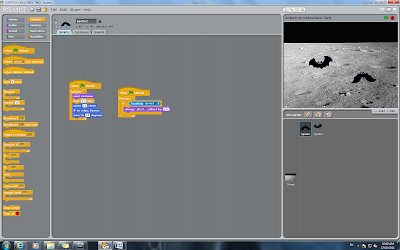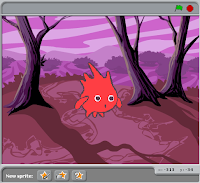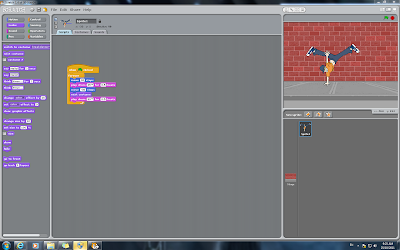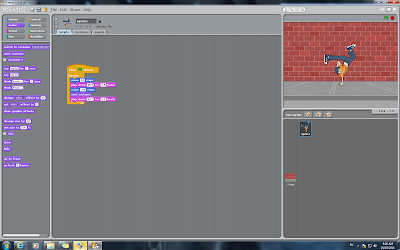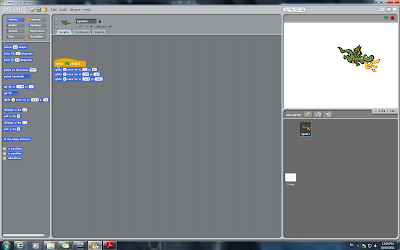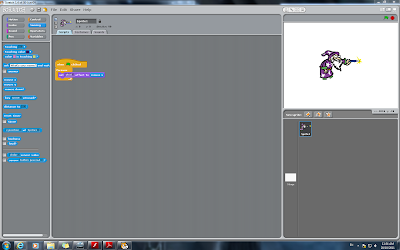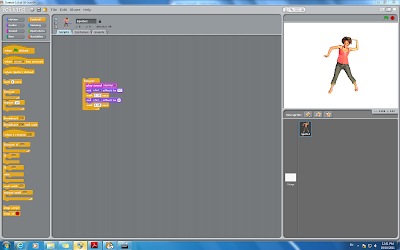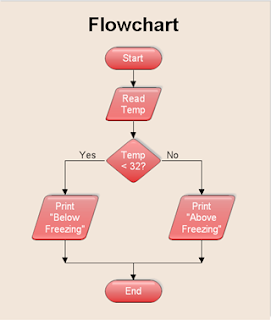Using the flying bat you created in challenge 3, now have your bat fly towards you, by using the “change size” function. Continuation of challenge 3 except more advanced.
Thursday, October 27, 2011
SCRATCH CHALLENGE 3#
Find the two bat sprites, one with wings up the other with wings down. Have the sprite change costume from one to the other, hence creating the illusion of flying.
Wednesday, October 26, 2011
SCRATCH CHALLENGE 2#
Create two sprites, have them randomly move around the screen (see challenge 1), when they touch have them stop (or react in some other way) SNAPSHOTS.
SCRATCH CHALLENGE 1#
Have your sprite glide across the screen and when it touches the edge (note: the “edge” can be sensed as a standard function), have it change directions.
Monday, October 24, 2011
CHANGE COLOUR.
This activity challenges us in order to use your character, and change its colours, either by pressing a button or within seconds. Overall a very simple and straightforward activity.
MOVE TO A BEAT.
This activity, takes you through the process of making your character move, this one consists of dancing and drum beats.
Wednesday, October 19, 2011
FOLLOW THE MOUSE.
This activity simply consists of your image or character, following the direction of the mouse, simple and easy. It was difficult to capture, the movement at the time of snapshotting, but this was the closest it went to. SNAPSHOTS.
GLIDE.
This activity, basically teaches you how to make your image, or character glide from one place to another, the process was quite simple and easy. SNAPSHOTS.
INTERACTIVE WHIRL.
I had quite fun while doing this activity, as it teaches us how to whirl, your image simply using your mouse. Depending where you move your mouse, the intensity of the whirl, increases. SNAPSHOTS.
SURPRISE BUTTON.
This activity explores how to create an animation with the help of sound. Basically, when the drum is clicked, the colour changes as well as a different sound is played when clicked.
Tuesday, October 18, 2011
DANCE TWIST.
This example, basically makes the character dance in a simple twist, presented as an animation. From the example, I changed one element from the algorithm which was making the control key, forever instead of when pressed. SNAPSHOTS.
ANIMATE IT.
In this example, scratch is used in order to create an animation. There is a simple dissolve in between two characters, changing together creating an easy animation.
DONE !
Thursday, October 13, 2011
KEEP SCORE.
In this sample, I had learnt how to create one aspect of the game, the score board. With this activity, I have got a more broad knowledge of what to do and with what certain tools. This activity is called Keep Score. Here are some snapshots, during the process of this activity.
STAGE ONE.
STAGE 3. FINAL.
DONE !
Wednesday, October 12, 2011
Scratch.
Recently I have been experimenting with a program named Scratch, so far I have learnt a couple of things, my first sample will be uploaded soon.
Monday, October 10, 2011
Flowcharts.
The flowchart featured on the left hand side basically consists of a variety of steps needed to follow.
The oval which says start indicates the beginning of the process and shows where it starts and stops.
With this the parallelogram representing the process steps and says read temp, branches into the process even deeper directing us to decisions.
The diamond representing decisions, and saying temp <32 gives us two choices, yes and or no. The arrows represent the process flow direction and help us decide which action we want to proceed with.
After choosing either the first option or the second option, from the parallelogram, you are finally faced with your final destination. The end, which once again is in the shape of an oval representing the start or the end.
The oval which says start indicates the beginning of the process and shows where it starts and stops.
With this the parallelogram representing the process steps and says read temp, branches into the process even deeper directing us to decisions.
The diamond representing decisions, and saying temp <32 gives us two choices, yes and or no. The arrows represent the process flow direction and help us decide which action we want to proceed with.
After choosing either the first option or the second option, from the parallelogram, you are finally faced with your final destination. The end, which once again is in the shape of an oval representing the start or the end.
Own Example of Algorithm.
Opening a door and entering the room.
Step towards the door.
Using your hand, grasp the door knob and slowly twist clockwise.
Gently push the door forward, as the room is revealed.
Remove the grasp on the doorknob.
Walk into the room.
Keep in mind of your surroundings.
Negotiating traffic lights as you drive down the street.
The traffic lights have turned red.
Slowly stop your car as you reach the traffic lights.
Look in the opposite directions in order to see the cars.
Patiently wait, till the traffic lights have changed to green.
As soon as they have turned green, slowly start driving down the street again.
Keep in mind of your surroundings and cars.
Step towards the door.
Using your hand, grasp the door knob and slowly twist clockwise.
Gently push the door forward, as the room is revealed.
Remove the grasp on the doorknob.
Walk into the room.
Keep in mind of your surroundings.
Negotiating traffic lights as you drive down the street.
The traffic lights have turned red.
Slowly stop your car as you reach the traffic lights.
Look in the opposite directions in order to see the cars.
Patiently wait, till the traffic lights have changed to green.
As soon as they have turned green, slowly start driving down the street again.
Keep in mind of your surroundings and cars.
Computer Algorithms.
Algorithm - Algorithms are a set of instructions, commonly known as procedures or functions, are used to perform specific tasks. These instructions can be seen as very simple, and on the other hand, very complex and difficult. A complex example of this can be sharpening a digital photo, the algorithm in this instance would need to process each pixel in the image and classify which one is neccessary to change, and at which level you need to change it to, that makes the image look sharper.
Pseudocode - This is the outline of a program, written in a certain form that creates the purpose of easily converting into real programming statements. Pseudocodes most important step, is producing the final code. This feature enables the programmer to concentrate on algorithms, without keeping in mind of all the syntatic details of a programming language.
Machine Language - The language which is only understood in technical terms by computers. Machine Language is almost near impossible for us, humans to assemble with because they consist entirely and only of numbers.
High Level Computer Language - This is a programming language, which enables a programmer to write programs that are independant of a specific type of computer. This language is called high - level as they are closer to human languages and very different from machine languages. High Level Computer Language is simple to read,write and consist.
Flowchart - These are graphical representations of the sequence of operations in an information program. The information program flowcharts direct us on towards how data flows from one source documents through the computer their final destination where it is distributed to users. Different symbols are drawn to represent different elements in the flowchart.
Sequence - An action or event, leading to the next assigned action in a predetermined order. This contains various amounts of actions, but none can be skipped in a sequence.
Selection - In a selection structure, questions are asked and focusing on the answer, this program takes one of two courses of action, in which leads the program on to the next event.
Repetition - This is known as the act of repeating, basically continous actions are acted through over and over again.
Pseudocode - This is the outline of a program, written in a certain form that creates the purpose of easily converting into real programming statements. Pseudocodes most important step, is producing the final code. This feature enables the programmer to concentrate on algorithms, without keeping in mind of all the syntatic details of a programming language.
Machine Language - The language which is only understood in technical terms by computers. Machine Language is almost near impossible for us, humans to assemble with because they consist entirely and only of numbers.
High Level Computer Language - This is a programming language, which enables a programmer to write programs that are independant of a specific type of computer. This language is called high - level as they are closer to human languages and very different from machine languages. High Level Computer Language is simple to read,write and consist.
Flowchart - These are graphical representations of the sequence of operations in an information program. The information program flowcharts direct us on towards how data flows from one source documents through the computer their final destination where it is distributed to users. Different symbols are drawn to represent different elements in the flowchart.
Sequence - An action or event, leading to the next assigned action in a predetermined order. This contains various amounts of actions, but none can be skipped in a sequence.
Selection - In a selection structure, questions are asked and focusing on the answer, this program takes one of two courses of action, in which leads the program on to the next event.
Repetition - This is known as the act of repeating, basically continous actions are acted through over and over again.
Subscribe to:
Comments (Atom)



